The unprecedented floods of August 2018 adversely affected Kerala’s agriculture. Rema K Nair, in this blog, reflects on how extension services came forward to support farmers to deal with the flood damage to crops, and how it is currently supporting farmers to deal with its long-lasting impacts.
CONTEXT
Kerala witnessed an unprecedented flood last August that critically affected the lives of people belonging to every walk of life. It goes without saying that farmers were the most affected as their houses and livelihoods were completely lost. It is estimated that an area of around 57,000 ha with standing crops of various types were lost in the deluge. Apart from the loss of machinery, farming implements, harvested and stored produce and damage to warehouses, irrigation channels etc., the incalculable loss of top soil and soil nutrients, are almost always overlooked.
 Impact on farms
Impact on farms
Crops worth more than INR 5600 crore were lost, affecting around 400,000 farmers. Approximately 150,000 ha of cropped land was affected. In August most of the flooded fields remained inundated for eight to ten days. The weight of 1 m3 of water is around 1 ton, and this water remained above the soil to a height of about 2 to 2.5 m. That means around 2 to 2.5 tons of mass exerted pressure over the soil making it compact. This made the soil impervious to air, and under anaerobic conditions the respiration of roots was affected. Plants, therefore, failed to take up water, and as a result once the floodwater receded the crops appeared to have completely dried up.
The nutrient status of the deposited soil varied from place to place. Nutrients, such as nitrates, and potash, along with micronutrients were washed off from the topsoil, especially from places at a high altitude. Some of these were partially deposited near banks and the rest had washed away into the sea. Under anaerobic conditions mostly pathogenic microbes flourish, whereas beneficial microbes, such as Vesicular Arbuscular Mycorrhiza (VAM) and Trichoderma, cannot survive. Gases such as nitrous oxide methane, and carbon dioxide, which are produced under flood conditions, accelerate the decay of roots. Anaerobes make use of these gases and grow. Most of the soils in Kerala are acidic. The post-flood analysis of soil has confirmed that acidity has increased several folds. This further creates problems in nutrient assimilation by soils. Loss of soil micro flora and macro flora, like earthworms, ants, etc., is a very serious problem that needs to be addressed urgently.
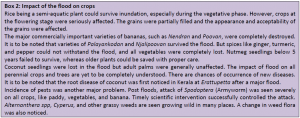 EXTENSION’S RESPONSE TO THE FLOODS
EXTENSION’S RESPONSE TO THE FLOODS
Dealing with the damage
Our first concern was how to protect the lives of farmers from a likely epidemic of leptospirosis, a distinct possibility due to a rise in the rodent population as a result of floods. The immediate response of the extension staff, especially of the State’s Department of Agriculture, was to inform farmers on the need to take doxycycline as advised by the Health Department.
Flood debris were removed by the farmers themselves. In places where the quantity of debris was too high, farmers were given assistance to the tune of INR 12,500 per ha. In several places, government agencies like Kudumbashree (http://www.kudumbashree.org/) were engaged in de-silting activities. Support from schemes such as MGNREGS were also used to implement these activities.
On a war footing extension functionaries visited each and every farmer to assess crop loss. This helped the farmers to get government aid at the earliest. During the visits individual farmers were given instructions on how to save their remaining crops, and how to get income from their fields.
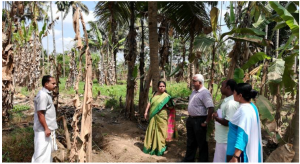 Farmers were advised to plough the topsoil so as to open up the soil’s pores and allow the soil to breathe. This was essential to prevent the formation of hard impermeable aggregates that could affect soil aeration further. The silt and clay that was deposited above the topsoil was broken down by the farmers and mixed with the soil.
Farmers were advised to plough the topsoil so as to open up the soil’s pores and allow the soil to breathe. This was essential to prevent the formation of hard impermeable aggregates that could affect soil aeration further. The silt and clay that was deposited above the topsoil was broken down by the farmers and mixed with the soil.
As regaining soil health was vital to restart agriculture, soil test campaigns were conducted in almost all panchayats to know the nutrient status of soil. In several places water-soluble nutrients, such as potash, calcium and magnesium, got dissolved and leached into the water. Soil acidity had increased considerably in most of the soils. Dolomite, gypsum, slaked lime and other soil ameliorants were supplied to farmers at a subsidised rate to regain soil health.
Farmers were encouraged to enrich the microbial activity in soil by ploughing in lots of green matter, farmyard manure and compost. Adding paddy husk was also adopted by farmers as this too can help in improving soil aeration. Moreover it adds to the silica content of the soil.
Beneficial microbes like Trichoderma, and VAM, were supplied to farmers to enhance the population of helpful microbes in soils that can aid in root growth and nutrient uptake. On-farm multiplication of VAM and Trichoderma was taken up as a front line demonstration in progressive farmers’ fields. These microbes help in control of soil-borne pathogens as well.
Cultivation of cover crops, especially leguminous crops, is promoted wherever possible as it will help in adding more organic matter to the soil and thus improve soil aeration and moisture retention as well as nitrogen fixation. Seeds of these crops were supplied to farmers.
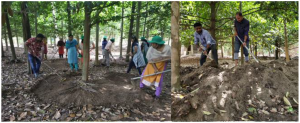 Farmers were advised to allow the growth of naturally occurring weeds as they have a deep root system that can improve soil porosity. They were also encouraged to adopt mulching of soil with organic matter, such as dried leaf and crop residues as this helps in moisture retention, ensure soil porosity, and improve microbial activity.
Farmers were advised to allow the growth of naturally occurring weeds as they have a deep root system that can improve soil porosity. They were also encouraged to adopt mulching of soil with organic matter, such as dried leaf and crop residues as this helps in moisture retention, ensure soil porosity, and improve microbial activity.
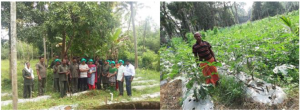 Short duration vegetable crops particularly amaranthus and cucurbits – can help the farmer to get some income immediately after the flood. So seeds and seedlings of these crops were supplied to farmers free of cost.
Short duration vegetable crops particularly amaranthus and cucurbits – can help the farmer to get some income immediately after the flood. So seeds and seedlings of these crops were supplied to farmers free of cost.
Extension staff convened campaigns under the title Punarjani (meaning ‘rebirth’) on the worst affected farmer fields to clear the debris, and add soil ameliorants. Seeds and seedlings were planted in these fields by extension staff.
 Building resilience
Building resilience
The Department of Agriculture Development & Farmers’ Welfare (Kerala) had launched a crop insurance programme a few years back. But farmers were reluctant to spend the initial premium even though it was nominal. But the floods have changed their attitude. Farmers currently recognize the importance of insurance as these types of unpredictable calamities and crop damage are likely to increase due to changing climate. Wide publicity is currently being given to the crop insurance scheme so that farmers can take up agriculture confidently. More farmers are currently approaching the extension staff to help get their crops insured.
Under the leadership of the Agricultural Technology Management Agency (ATMA), farm schools, farm field schools, capacity-building meetings, kisan gosthis were conducted in all panchayats to popularize scientific intervention in agriculture and allied fields. Apart from this, since a lot of nutrients were lost in floodwater, we are carefully assessing nutrient deficiency symptoms.
Crops like pepper, nutmeg, and other spices need a comprehensive package for rejuvenation. Perennial crops also need periodical surveillance given the incidence of new pests and disease. Under the crop health programme, extension staff are deployed to keep a vigil on the occurrence of pests and diseases.
Farmers are also being encouraged to take up additional activities, such as fisheries, animal husbandry, and value addition so as to ensure a steady income.
END NOTE
Despite this staggering calamity agriculture continues to be the biggest employment generating sector in Kerala even today. So the revival of this primary sector is vital in rebuilding Kerala in the post-flood scenario. This would necessitate more coordinated efforts from the Kerala Agricultural University and the State Department of Agriculture Development and Farmers Welfare. The greatest challenge facing the extension community is how to cope with the unpredictable situations that will continue to develop as a result of climate change.
It’s high time that we shift to crops that demand less water and have high water use efficiency. Moreover, wetlands and paddy lands play the most important role in containing floodwaters. Deforestation in the hills and unscientific cultivation of soil-eroding crops on slopes have to be checked in order to increase the soil binding capacity and water retention. Simultaneously, the remaining wetlands and paddy fields have to be preserved through flood reservoirs that can avert loss to people and their belongings. Stringent action has to be taken against those who violate existing wetland preservation laws.
The crop insurance scheme has to be revamped to suit each agroecological zone. Agroecological zones – coastal, plains, hilly —have to be differentiated based on their its soil and climatic characters. Based on the special features of each agroecological zone suitable crops and cultivars are to be identified. An integrated farm-based approach will be helpful in increasing farmers’ incomes and reducing the associated risks instead of a crop-based approach that’s being adopted now. Certain varieties of spices, such as pepper, nutmeg, ginger and turmeric, showed significant abilities to withstand adversities. Studies have to be conducted to identify and multiply these varieties.
Disaster risk reduction has to be included in the curriculum, not only in agriculture but in allied sectors as well, as we envisage a change in climate that would trigger cyclones and storms more often. Training is to be imparted to extension officials using national level training agencies, like the National Institute of Agricultural Extension Management (MANAGE), and it has to be ensured that the knowledge imparted through such trainings percolate down to target groups.
Agriculture should be the main focus of efforts at rebuilding Kerala as the floods have proved beyond doubt that food is the most important commodity for human survival. “Annadatha Sukhibhava”. Therefore, society has a grave responsibility to ensure the well being of the farming community.

Rema K Nair is Deputy Director, Department of Agriculture Development & Farmers’ Welfare, Government of Kerala, Thodupuzha, Idukki (Email: remanairagri@gmail.com).

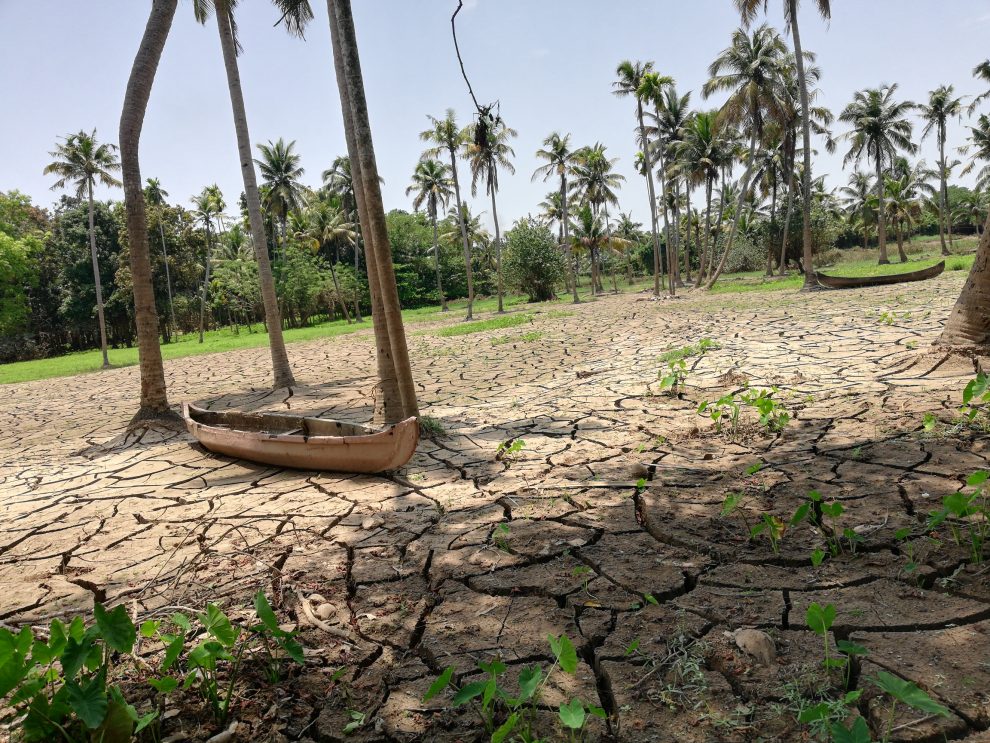

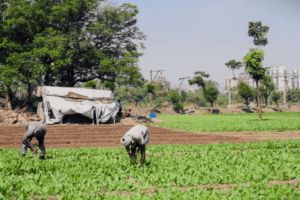

https://www.aesanetwork.org/blog-91-natural-disasters-and-extension-advisory-services-eas-lessons-for-better-preparedness/?fbclid=IwAR22IdgQxWZBNw78dGvYIQmNzFSdMuygkGBihvTcH2LjSpdHgQazYBiY0Xc
This blog brings field realities during and aftermath of natural calamity like floods, while narrating the various actions and problems in doing relief work taking the case of Kerala floods of 2018. The suggestion is very valid that Disaster risk reduction has to be included in the curriculum, not only in agriculture but in allied sectors as well, since climate change trigger cyclones and storms more often. There is already a compulsory non credit course entitled ‘Disaster Management’ introduced in 2009 by ICAR at Master’s level agricultural education in Indian universities. Also, the suggestion training is to be imparted to extension officials using national level training agencies, like the National Institute of Agricultural Extension Management (MANAGE), while ensuring the knowledge imparted through such trainings percolate down to target groups is appreciable. These kinds of blogs when written by development department officials, makes it very useful due to practical insights based on their personal experiences. I congratulate Ms Rema Nair for taking time to write such a practical blog post for AESA. Looking forward for more such practical blogs at AESA platform, congratulations!
This blog brings a new perspective on the role of extension functionaries in helping the farmers in the post-flood conditions through technological interventions. A well-articulated blog described the systematic approach followed by state extension machinery in managing the post-flood situations effectively.
The post-flood operations in Kerala were well-managed from saving lives of human and livestock, distributing the relief materials, to helping farmers. The youth esp students of various academic institutions including KAU, were directly involved in the post-flood operations to help the farmers. A state-wide survey was also conducted by ICAR scientists along with state extension professionals who traveled to all the districts to estimate the crop loss. A massive seeds/ planting materials distribution drive was launched by various Institutions who supplied quality seeds to the needy farmers. The state govt did a commendable job in managing the post-flood situation esp among farmers.
Thanks you very much for making available = Blog 101- Learning from the Kerala Floods of 2018.
I find it very interesting and informative and hope some lessons will be drawn from this ‘Learning’ and used in future since Floods and Droughts are to stay with us and we have to deal with these situations – every year – somewhere or the other.
I have two comments or say suggestions for your consideration =
It is mentioned that with the help of ‘ATMA farm schools, farm field schools, capacity-building meetings, kisan gosthis were conducted in all panchayats to popularise scientific intervention in agriculture and allied fields’. I wish these exercises would have been used to ‘Understand Perceptions & Priorities of the farmers and discuss Scientific Interventions as well – may be some interventions have to be modified on this basis’. A similar exercise to understand farmer’s views about the results/outcome of interventions would have been useful = may be it was conducted.
A statement in the End Notes attracted my attention – wherein it is stated ” Certain varieties of spices, such as pepper, nutmeg, ginger and turmeric, showed significant abilities to withstand adversities. Studies have to be conducted to identify and multiply these varieties.” I hope these varieties are identified/studied and considered for propagation for future as this would make big difference for farmers.
Good to read the way the state Department of Agriculture came forward to help farmers in flood affected areas. The Department could do well in providing extension advisory on various technical aspects of crop husbandry to minimise the losses and also in arranging for financial assistance to the affected families on the basis of extent of damage and also facilitating crop insurance. Congratulations and thanks to Smt.Rema K Nair for giving details on ways and means to succour the flood affected farmers.
We encountered a serious problem when we visited the families affected during Thane cyclone in Cuddalore district in Dec 2011 ( IVEF workshop ). All poultry farmers incurred heavy losses through cent percent mortality of the chicks as well as damage to the sheds. Excepting hand full of large farmers, the rest could not get any compensation from the Government, as these farms were not registered and there were no records of these farmers with the Department of Animal Husbandry. The Office of the District Collector also could not get details regarding the number of poultry farmers affected, number of birds died and the extent of damage to the sheds and the rates for compensation to be paid. However, most of the farmers could get compensation for the loss of coconut trees and the paddy fields as the Department of Agriculture gave the details of individual farmers within few days after the cyclone and based on the guide lines the Government could compensate for the losses.
To help framers operating in flood prone areas a two pronged approach is necessary. Firstly, enable the farmers to face the floods to minimise the losses ( before the floods) and Secondly, enable them to recover fast from the impact of floods ( after the floods) i.e. how to save the remaining crops, how to salvage the crop produce and how to increase their income. Based on her experience in dealing with flood affected families, Smt. Rema K.Nair can prepare a document on these aspects which could be of help to those families living in areas prone for floods.